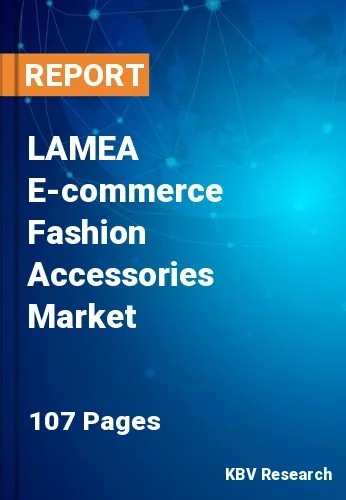The Latin America, Middle East and Africa E-commerce Fashion Accessories Market would witness market growth of 15.9% CAGR during the forecast period (2023-2030).
AI-powered styling assistants provide outfit recommendations, including the perfect fashion accessories to complement a chosen look. These tools help consumers make informed decisions about their accessory purchases. 3D printing technology is revolutionizing the way fashion accessories are designed and produced. Some e-commerce brands offer customizable 3D-printed accessories, allowing consumers to have unique, one-of-a-kind pieces. Blockchain technology is being used to verify the authenticity of high-end fashion accessories. Customers can trace the origin and ownership history of luxury items, reducing the risk of counterfeits. E-commerce brands are taking a stand on social and political issues, and consumers support brands that align with their values. This form of socially responsible commerce has an impact on fashion accessory purchases.
Latin American consumers often appreciate artisan and handmade fashion accessories. E-commerce platforms support local artisans, allowing them to reach a wider audience. The Middle East is experiencing a digital transformation, with high internet penetration and growing smartphone usage, making e-commerce more accessible and convenient. The Middle East is known for its interest in luxury fashion. E-commerce platforms provide access to high-end and luxury fashion accessories worldwide. Cross-border e-commerce is gaining traction in Africa, allowing consumers to access a broader range of fashion accessories from international sellers. Africa faces logistics challenges, including the last-mile delivery of products.
As per the International Trade Administration, the UAE is the leader in e-commerce among the Gulf Cooperation Council (GCC) states, with e-commerce sales reaching a record $3.9 billion in 2020, representing 10% of total retail sales. This was primarily the result of a COVID-19 digital transition. The Dubai Chamber of Commerce and Industry indicates that e-commerce will render $8 billion in sales by 2025 as the UAE industry has nearly 100 percent internet and mobile phone penetration.
According to the International Trade Administration, South African online sales increased 66% from 2019 to 2020 to more than $1.8 billion (ZAR30 billion). The growing online sales is expected to expand the market growth across the region.
The Brazil market dominated the LAMEA E-commerce Fashion Accessories Market by Country in 2022, and would continue to be a dominant market till 2030; thereby, achieving a market value of $20,416.7 million by 2030. The Argentina market is showcasing a CAGR of 16.6% during (2023 - 2030). Additionally, The UAE market would register a CAGR of 15.6% during (2023 - 2030).
Based on Product Type, the market is segmented into Watches & Jewelry, Luggage & Bags, and Others. Based on countries, the market is segmented into Brazil, Argentina, UAE, Saudi Arabia, South Africa, Nigeria, and Rest of LAMEA.
Free Valuable Insights: The Worldwide E-commerce Fashion Accessories Market is Projected to reach USD 630.2 Billion by 2030, at a CAGR of 15%
The market research report covers the analysis of key stake holders of the market. Key companies profiled in the report include H & M Hennes & Mauritz AB, Walmart, Inc., Amazon.com, Inc., Nike, Inc., Industria de Diseno Textil, S.A. (Inditex S.A.), eBay, Inc., ASOS Plc (Frasers Group), Revolve Group, Inc., Zalando SE, and Nordstrom, Inc.
By Product Type
By Country
Our team of dedicated experts can provide you with attractive expansion opportunities for your business.

